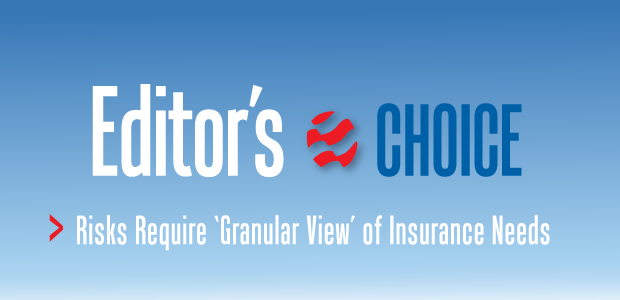
Risks Unique To Upstream Require ‘Granular View’ Of Insurance Needs
Editor’s Note: Oil and gas companies are hoping the downturn is at last beginning to turn upward. U.S. rig counts increased by nearly 40 percent through the summer and fall, reversing an 18-month slide that had diminished the number of active rigs to historic lows last spring.
For their part, U.S. independent oil and gas producers are eager to return to work, given the right market signals and sufficient confidence in the risk/reward equation. But it will be a long way back. As of mid-November, rig counts still were down 25 percent year-to-year .
The downturn has taken a toll on the upstream industry, as well as ancillary industries that provide goods and services to support exploration, drilling, completion and production.
What about insurance? Has oil and gas insurance capacity, or the availability and cost of insurance and risk management products, been impacted? Are there particular coverage areas that could become a concern when a recovery does materialize? How can operators make sure their insurance policies will accommodate the requirements and operational timing of drilling and development projects scheduled for 2017?
To answer these questions and survey the state of oil and gas insurance, AOGR presented a series of questions to Eric Boquist, president of Travelers Oil & Gas. Questions are in italics, followed by Boquist’s responses.
Q: What is the insurance sector’s general outlook on U.S. oil and gas activity in 2017? To what degree do insurers anticipate drilling and completion activity will increase over the next 12-18 months? What do those expectations imply about general upstream insurance trends?
BOQUIST: Based on conversations with our customers, there is reason for optimism. Drilling activity is returning slowly. The oil and gas industry is trying to find the “new normal” where oil field activity returns to a steady pace. This slow period has allowed the industry to reduce operational costs and decrease well completion times. This trend may allow for a more immediate effect on overall U.S. production.
The insurance industry for oil and gas has remained flexible and nimble in adjusting to the volatile shifts in production. We have been working closely with companies to prepare them for the next upturn in oil and gas prices, and subsequent increase in field activity. This includes helping to manage the life cycle of employees and workers’ compensation costs.
While some oil and gas companies already have good programs in place, insurers should be working continually with their customers to identify gaps in their programs, regardless of whether they are experiencing increased or decreased activity in the field.
Q: Oil and gas companies’ insurance needs change constantly in reaction to business conditions. In what ways has the downturn impacted the dynamics of oil and gas risk management? What business demands are being placed on insurers themselves, and how are they responding to help operators mitigate risk?
BOQUIST: The downturn has given everyone in the industry, including insurers, the chance to focus on being more efficient. We have spent a substantial amount of time helping our customers by educating them about exposures they may not consider when production levels are higher. For example, we met with more than 350 agents and existing and potential customers this year to share perspectives from claims professionals on how to handle contractual risk transfer issues.
Increased use of automation has helped efficiency during the downturn. While this has reduced workers’ exposure to injury, the dangers of working in this business persist. Technology improvements have created a new type of threat: complacency. Companies occasionally confuse a reduction in risk with immunity to risk, and as a result, may fail to monitor safety processes as closely as they should. Better technology cannot fully eliminate safety risks, no matter the economic conditions.
Q: What should producers expect in terms of coverage availability in 2017? Are there any particular coverage or policy areas of concern to oil and gas companies in the year ahead?
BOQUIST: Our expectation is that coverage availability will remain consistent in the coming year.
In addition to an annual review of exposures for property, liability and contract liabilities, oil and gas companies need to start thinking about cyber exposure. According to the U.S. Department of Homeland Security, the energy sector (46 reported incidents) was second only to critical manufacturing (97 reported incidents) in cyber attacks in 2015. In 2014, the energy sector led all industries with 79 reported incidents.
In the past, many considered the traditional upstream systems in oil and gas to be relatively immune from cyber risks because they were isolated. However, the industry’s growing use of technology and the demands for real-time data have introduced new risks. Security efforts related to upstream drilling infrastructure are focused on physical assets, rather than information. The oil and gas industry faces unique threats, including attacks by activists and environmental groups, and theft of intellectual property and data, along with theft of employee information.
Working closely with an agent or broker to annually review his insurance program helps an operator address and manage the business’s unique risks and financial responsibilities.
Q: Domestic activity is concentrating in unconventional plays. What does this focused activity, and the operational procedures and practices that come with horizontal resource plays, mean to insurers? From an insurance perspective, do risk profiles differ from one resource play to another?
BOQUIST: One of the exposures we are seeing is a well that is drilled, but uncompleted (DUC). According to the U.S Energy Information Administration, there were 5,031 DUCs at the end of August. That included 4,117 wells in the oil-prone Bakken, Niobrara, Permian and Eagle Ford, and 914 in the gas-prone Marcellus, Utica and Haynesville.
DUC counts have been decreasing in recent months in both oil and gas plays. However, in 2014, the ratio of DUCs-to-completions was about 2-to-1 for oil plays and 4-to-1 in gas plays. At the end of August this year, it was closer to 9-to-1 and 7-to-1, respectively.
There are always some DUCs, because there always will be times when drillers need to postpone completing some percentage of horizontal wells because of operational, infrastructure, economic and other factors. When we evaluate individual risks, we look at which properties are producing, which are undeveloped, which have DUC exposure, etc.
That said, insurance coverage is fairly well-defined and the product does not change with geography. It is more about the purchasing decision as customers buy different limits for different loss scenarios. For example, some parts of the country that produce more liquids can have more environmental exposures versus areas that produce mostly dry gas.
Q: What are the overall insurance pricing expectations for 2017? Are there any specific coverage areas where policy costs are expected to increase? What major factors outside the industry could impact oil and gas insurance cost trends?
BOQUIST: Pricing is always a risk-by-risk conversation that is based on the specific exposures of each account. Each oil and gas company operates differently, and it is best served by taking an individual approach to rating insurance costs. That means insurers must take a granular view of each line of coverage to adjust their thinking and approach according to each insured’s risk characteristics.
The line of insurance that continues to be impacted by increased loss frequency and severity is commercial automotive. Motor vehicle crashes are the leading cause of work-related deaths in the United States, accounting for 22,000 from 2003 to 2014, according to the CDC Foundation. In 2013, motor vehicle crashes cost U.S. employers $25 billion, averaging $671,000 per death and $65,000 per nonfatal injury.
As the economy improves, more vehicles are covering more miles, pushing up the frequency of auto accidents, resulting in large losses and increased damage awards. Some of the risks impacting commercial auto losses include:
- Escalating medical costs;
- Distracted driving;
- Personal auto usage for work; and
- Increasing attorney involvement.
The average motor vehicle accident-related workers’ compensation claim is almost twice the cost of the average claim for other types of accidents, according to the National Safety Council. Any employee who drives as part of his duties is exposed to getting injured in an auto-related accident, even if he drives only on occasion.
Oil and gas companies can have many workers that drive sporadically for company purposes, and as a result, organizations may underestimate the number of people who drive as part of their work days. Claims may arise from a “nonidentified” driver who was given the keys for a single trip only, sometimes not even leaving a work site.
Distracted driving is a growing problem generally on America’s roads. We know the dangers of impaired driving, but how many drivers realize the electronics they take for granted–entertainment systems, cell phones (even hands-free can be a distraction) and global positioning systems–are distractions that take not only their eyes, but also their minds, off the road?
The appropriate non-owned auto coverage will help protect oil and gas companies in the event an employee is involved in an accident while driving his personal vehicle on company business. This is a significant area of potential liability for operators that often is overlooked because the lines between what is business and personal use sometimes can be blurred.
Finally, claim costs are increasing as more lawyers get involved in more aspects of driving-related incidents.
Q: As operators set their 2017 drilling and development schedules, what can they do to tailor their insurance programs to meet the timing and needs of their planned field activities? How can they work with their insurers to better manage bottom-line costs while ensuring adequate coverage to mitigate risk exposures and safeguard against unforeseen liabilities?
BOQUIST: Having their brokers and carriers involved in the early stages of planning can help oil and gas companies identify potential problems, and can provide solutions in the event an incident does occur. For example, companies should consider whether they are carrying additional limits (excess coverage) above their primary automotive policies. An oil- and gas-related auto claim can exhaust primary limits and extend into an excess layer of coverage.
Operators and contractors also should institute rigorous inspection programs with written record keeping to note the frequency of inspections, and have comprehensive equipment maintenance programs to help avoid breakdowns and potentially dangerous situations.
Access to spare or replacement parts for key machinery also is recommended to limit possible business interruption. Proper handling of equipment that may have been dormant for months will be a critical component of managing costs. If equipment is not well-maintained and regularly inspected, operators can lose control easily, causing damage to other nearby equipment and injury to employees.
By working closely with their brokers and insurance carriers, oil and gas companies can tap into a variety of resources, including risk assessment services, best-practice guidance, and tools to make implementing training and safe procedures easier. One of our guiding principles is to make customers better for being associated with us. Insurers should be committed to a dual obligation, and it is imperative they help make the oil and gas industry better.

Eric Boquist is president of Travelers Oil & Gas. He has more than 25 years of insurance industry experience. Boquist’s background includes managing a wide array of energy risks, including U.S. and international exploration and production, international power, and worldwide downstream risks. Travelers Oil & Gas provides specialized insurance for a diverse range of customers of all sizes–including both onshore and offshore operations–with a comprehensive focus on exploration and production, including customized products covering equipment, liability, property, and workers’ compensation.
For other great articles about exploration, drilling, completions and production, subscribe to The American Oil & Gas Reporter and bookmark www.aogr.com.






